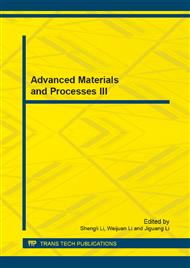p.617
p.621
p.626
p.633
p.637
p.641
p.646
p.650
p.654
Carbon Capture Performance of Amino-Modified MIL-101 at Room Temperature
Abstract:
MIL-101, a metal-organic framework material, was synthesized by the high-temperature hydrothermal method. Triethylenetetramine (TETA) modification enabled the effective grafting of an amino group onto the surface of the materials and their pore structure. The crystal structure, micromorphology, specific surface area, and pore structure of the samples before and after modification were analyzed with an X-ray diffractometer, scanning electron microscope, specific surface and aperture tester, and infrared spectrometer. The carbon dioxide adsorption properties of the samples were determined by a thermal analyzer before and after TETA modification. Results show that moderate amino modification can effectively improve the microporous structure of MIL-101 and its carbon dioxide adsorption properties. After modification, the capacity of MIL-101 to adsorb carbon dioxide decreased only by 0.61 wt%, and a high adsorption capacity of 9.45 wt% was maintained after six cycles of adsorption testing at room temperature and ambient pressure.
Info:
Periodical:
Pages:
637-640
Citation:
Online since:
September 2013
Authors:
Price:
Сopyright:
© 2013 Trans Tech Publications Ltd. All Rights Reserved
Share:
Citation:


